
a web page by Don Roberson |
 |
||
CURASSOWS & GUANS Cracidae |
||
|
||
The presence of cracids often indicates a truly wild place — a wilderness where man has not hunted out the big gamebirds. One such place is the Brazilian Pantanal, where Bare-faced Curassow and Razor-billed Curassow Crax tuberosum are the big cracids, and Chestnut-bellied Guan (below) forages in the flowering canopy in the early morning. |
||
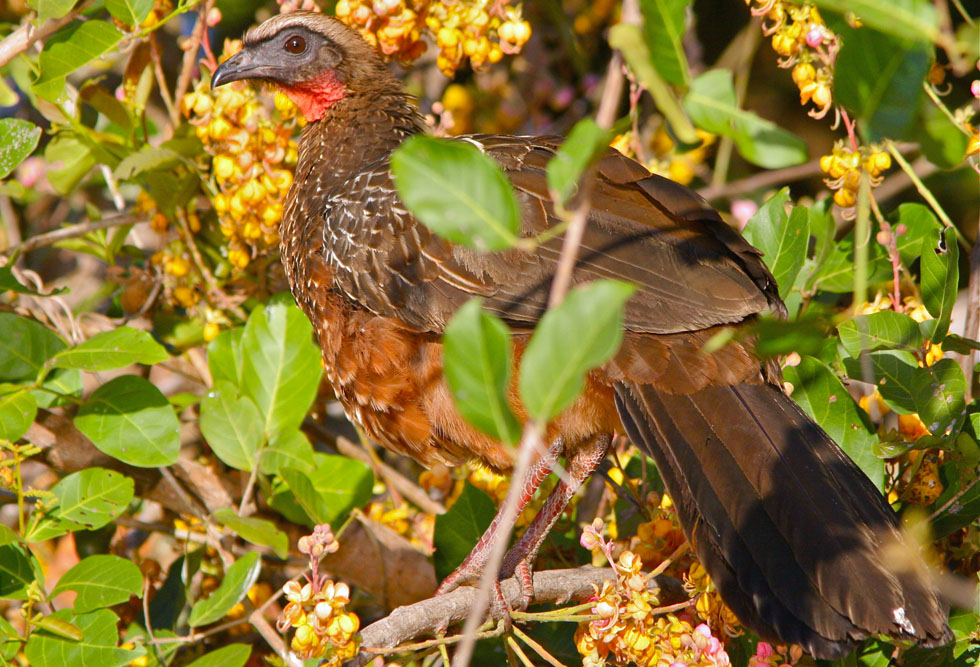 |
||
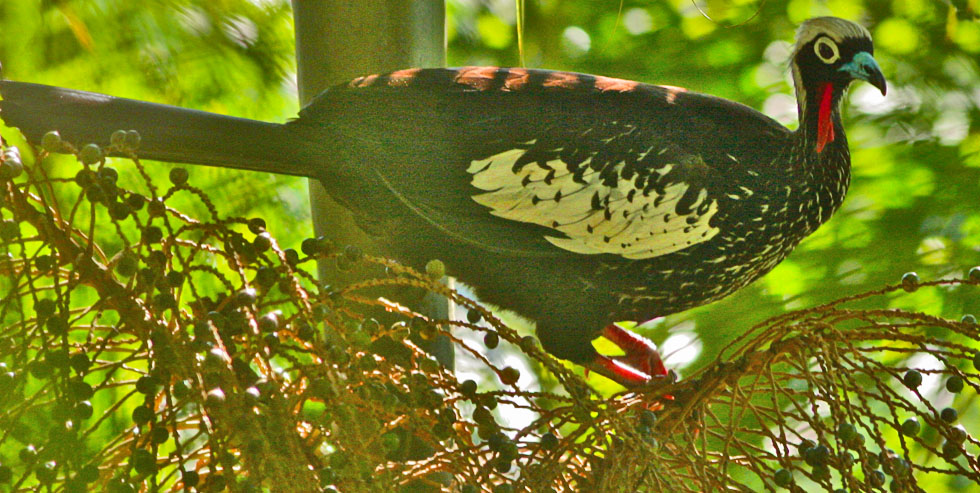 |
||
I recall hearing about the Nocturnal Curassow Nothocrax urumutum whose guttural "hoo, hoo-hoo, hoo-hoo-hoo" cries were only heard after it is fully dark and that are virtually impossible to see day or night. For some years it was the late, legendary Ted Parker's "most wanted bird;" I know he did see several eventually. I've read recently of tours that located the chimera. |
||
It remains one of the "best birds" in the world for the globe-trotting field birdwatcher. In April 1986, I joined a tour for a week's visit to El Triunfo, Mexico. This involves a three-day hike from the coastal Pacific lowlands to the cloud forest at 6000' elevation where we camped in tents. The entire trip was great for birds but it was a poor year for Horned Guan. A couple folks had a pair fly across a trail in front of them, but I never saw a single feather of this much-desired beast. Despite missing Horned Guan, there were fine experiences that trip with Highland Guan Penelopina nigra. Most of those were up in trees, often a fruiting tree. [I will have to return someday; my friend Greg Lasley has led a series of successful tours there for VENT tours. . . . Note: This paragraph was written in 2000 for the first edition of this web page . . .] Sixteen years later (March 2002) I returned to El Triunfo on a VENT trip with Greg Lasley and others. This time we drove to the east slope, had a much shorter hike up the "back side," and later re-hiked the Pacific slope over multiple days downslope. On this second trip we had several encounters with Horned Guan in the cloud forest, and I was able to get my own photos, albeit still in the days of slide film (two are digitized below). |
||
|
||
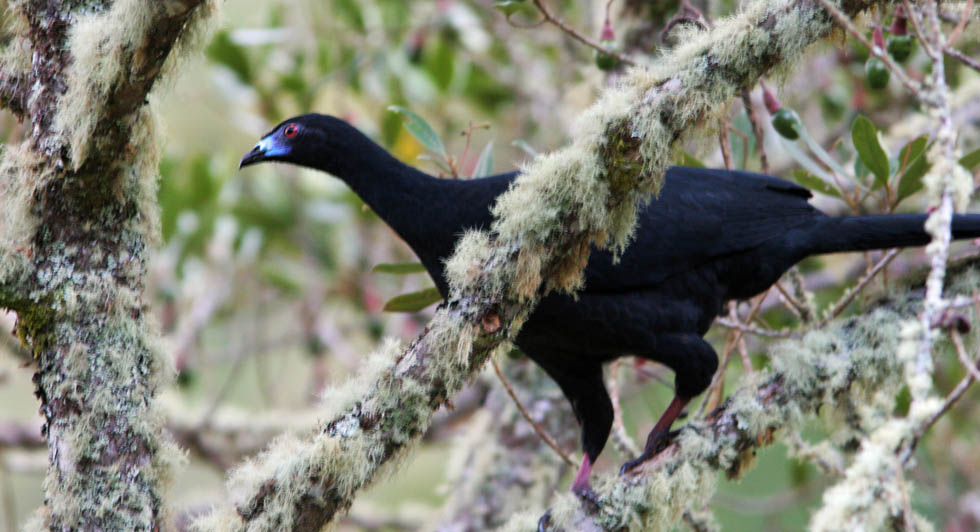 |
||
A dozen cracids are chachalacas in the genus Ortalis. All chachalacas are rather drab in plumage and they lack the fancy casques, strange bills, or head plumes of some larger cracids; they are thus considered the most primitive form of a cracid. The northernmost population reaches the U.S. along the Rio Grande River of south Texas; it is Plain Chachalaca (right; so tame in Santa Ana NWR, at least in 1972, that I took this shot, one of my earliest bird photos, with a point-and-shoot camera). The southernmost species is Chaco Chachalaca of the Pantanal (below). The loud rolling chorus of a band of onomatopoeic chachalacas is a happy sound of tropical mornings. |
||
 |
||
As a family the Cracidae have numerous taxonomy issues of contention over species and generic limits. The various piping-guans Pipile, for example, have been all lumped together into one species or separated out into as many as six different species. The Handbook of Birds of the World, Vol. 1 (del Hoyo 1992), written before the rise of genetic analysis, segregated the six taxa in Pipile into four species, and that approach remains the mainstream status of the piping-guans to this day. Both the Blue-throated Piping-Guan P. cumanensis and Red-throated Piping-Guan P. cujubi have distinctive subspecies [cumanensis and grayi, cujubi and nattereri, respectively] that some authorities had previously split as additional species. We'll conclude with this photo of Dusky-legged Guan, a cracid of lowlands forests in southeast Brazil, northern Argentina, Paraguay, and Bolivia. This shot was taken on a very foggy early morning as the guan wandered out of branch to check on the status of potential fruit there. With the thick ground fog obscuring the forest, the photo reminds me of artwork that is present throughout my much-beloved book Curassows and Related Birds (1973). |
||
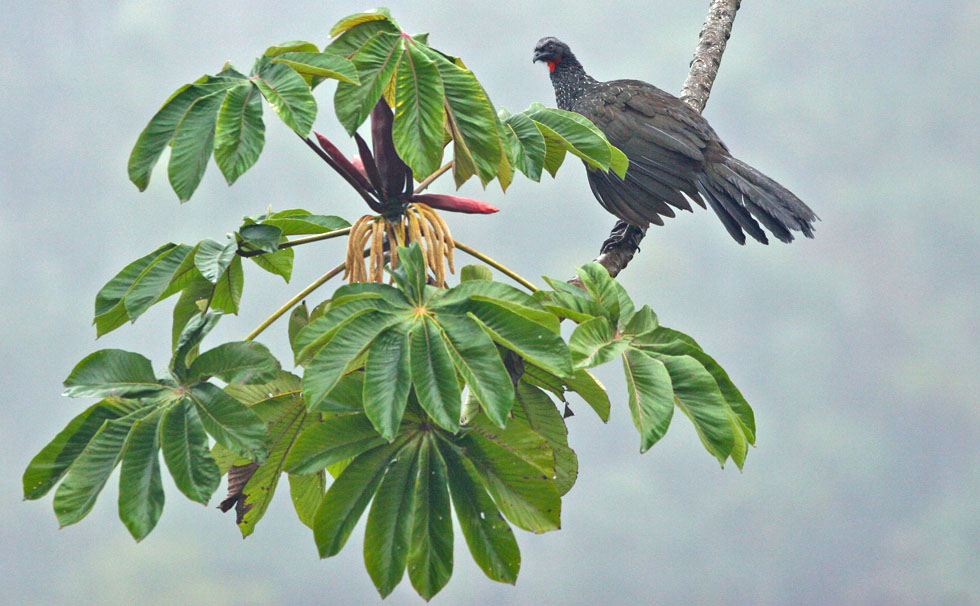 |
||
Photos: The pair of Trinidad Piping-Guan Pipile crepitans was at the Green River area of Trinidad in Dec 2006. The head of a Bare-faced Curassow Crax fasciolata was attached to a male in the Pantanal, Brazil, on 20 July 2010, and the Chestnut-bellied Guan Penelope ochrogaster was photographed there that same day. The Black-fronted Piping-Guan Pipile jacutinga was at Intervales NP, Brazil, on 31 July 2010. The male Great Curassow Crax rubra was at La Selva, Costa Rica, on 18 Dec 2007. The great art of Horned Guan Oreophasis derbianus was by Albert Earl Gilbert and published in Delacour & Amadon (1973); this photo of a page from the book doesn't really do justice to the work. My two photos Horned Guan were taken in the cloud forest of El Triunfo, Chiapas, Mexico, in March 2002. The arboreal Black Guan Pipile crepitans was at Le Savegre, Costa Rica, on 23 Dec 2007. The point-and-shoot close-up of Plain Chachalaca Ortalis vetula was at Santa Ana NWR, Texas, USA, on 16 July 1972. The Chaco Chachalaca Ortalis canicollis was in the Brazilian Pantanal on 19 July 2010. The artsy pic of Dusky-legged Guan Penelope obscura was Itiatia NP, Brazil, on 4 Aug 2010. All photos © Don Roberson; all rights reserved. Artwork shown from Delacour & Amadon (1973) is © Albert Earl Gilbert. Family Book:
Literature cited:
|
 Curassows, guans, and chachalacas — together known as cracids — are an ancient family whose closest relatives may be the megapodes of Australasia. The oldest fossil cracid is from 50 million years ago in what is now Wyoming (del Hoyo 2002). Today, cracids are exotic, elusive, and sometimes spectacular denizens of steaming lowland jungles, misty cloud forests, or arid scrub woodland in the Neotropics. Some of them, such as Trinidad Piping-Guan (above) are now critically endangered. As gallineous birds, they fill a niche that pheasants do in the Old World. Though without the spectacular colors of some exotic Asian pheasants, some curassows have impressive crests (as does this male Bare-faced Curassow, left), while others have fancy casques or horny spikes atop their heads.
Curassows, guans, and chachalacas — together known as cracids — are an ancient family whose closest relatives may be the megapodes of Australasia. The oldest fossil cracid is from 50 million years ago in what is now Wyoming (del Hoyo 2002). Today, cracids are exotic, elusive, and sometimes spectacular denizens of steaming lowland jungles, misty cloud forests, or arid scrub woodland in the Neotropics. Some of them, such as Trinidad Piping-Guan (above) are now critically endangered. As gallineous birds, they fill a niche that pheasants do in the Old World. Though without the spectacular colors of some exotic Asian pheasants, some curassows have impressive crests (as does this male Bare-faced Curassow, left), while others have fancy casques or horny spikes atop their heads.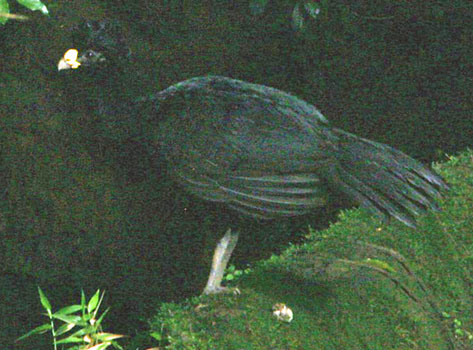 Especially prized among birders are the really big curassows, as well as 4 species of piping-guans in genus Pipile. Because these are huge chicken-like birds, everywhere that man expands and develops in the Neotropics, the guans and curassows are among the first birds to disappear. The Alagoas Curassow Mitu mitu of eastern Brazil is surely extinct in the wild (a few remain in captivity). Those considered endangered include Black-faced Piping-Guan of the remnant forest of southeastern Brazil (above, foraging in a fruiting palm). The big curassows in the genera Mitu, Pauxi, and Crax have deep haunting voices that are also special. This huge male Great Curassow is almost lost in the shadows as it stands atop a mossy log adjacent to a Costa Rican river (right).
Especially prized among birders are the really big curassows, as well as 4 species of piping-guans in genus Pipile. Because these are huge chicken-like birds, everywhere that man expands and develops in the Neotropics, the guans and curassows are among the first birds to disappear. The Alagoas Curassow Mitu mitu of eastern Brazil is surely extinct in the wild (a few remain in captivity). Those considered endangered include Black-faced Piping-Guan of the remnant forest of southeastern Brazil (above, foraging in a fruiting palm). The big curassows in the genera Mitu, Pauxi, and Crax have deep haunting voices that are also special. This huge male Great Curassow is almost lost in the shadows as it stands atop a mossy log adjacent to a Costa Rican river (right).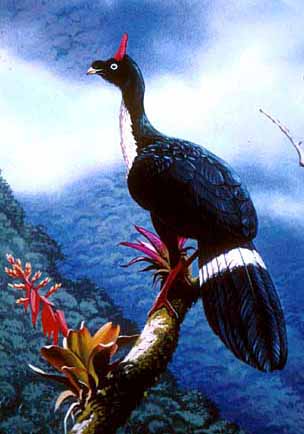 Surely the greatest of all cracids must be the rare and local Horned Guan of cloud forests in Chiapas, Mexico, and adjacent Guatemala. One of my all-time favorite bird art is this painting by Albert Earl Gilbert of a Horned Guan (left) from Delacour & Amadon's (1973) monograph on the Cracidae. Gilbert's painting evokes the crisp cool feeling of the mountain air and what must be the breathtaking experience of watching such a great bird. Many years ago Ted Parker told me of his first visit to El Triunfo (Chiapas, Mexico) in which he and a couple friends documented the first known youngsters of Horned Guan (details were later published in Parker et al. 1976).
Surely the greatest of all cracids must be the rare and local Horned Guan of cloud forests in Chiapas, Mexico, and adjacent Guatemala. One of my all-time favorite bird art is this painting by Albert Earl Gilbert of a Horned Guan (left) from Delacour & Amadon's (1973) monograph on the Cracidae. Gilbert's painting evokes the crisp cool feeling of the mountain air and what must be the breathtaking experience of watching such a great bird. Many years ago Ted Parker told me of his first visit to El Triunfo (Chiapas, Mexico) in which he and a couple friends documented the first known youngsters of Horned Guan (details were later published in Parker et al. 1976). 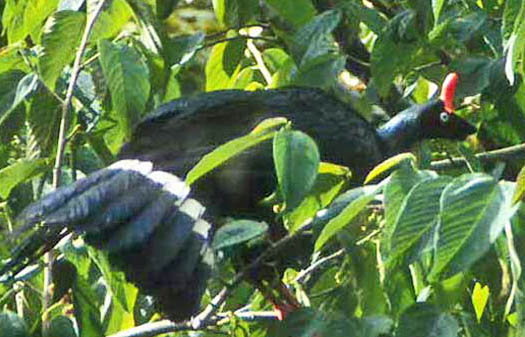
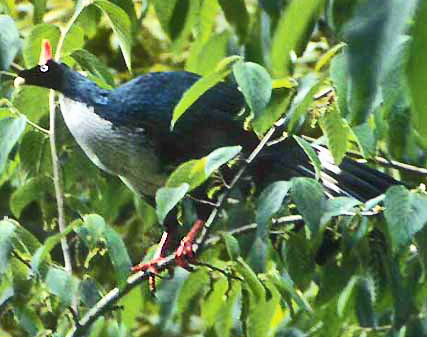
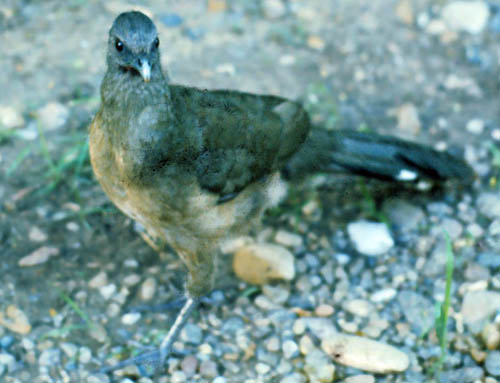 Cracids are more arboreal than other large gamebirds, and while they often feed on the ground they typically roost in trees. The habitats they use are wooded but extremely variable. Black Guan (above) is a classic cloud forest species, moving high into the canopy in search of fruit. Look at the rich mossy limbs it explores. This same tree in montane Costa Rica also held a Resplendent Quetzal. In contrast, the rare White-winged Guan Penelope albipennis of northwestern Peru is resident in remnant patches of arid scrub. It was thought to be extinct until rediscovered in 1977; now, important habitat is a reserve and birders can stay at a lodge nearby to see it.
Cracids are more arboreal than other large gamebirds, and while they often feed on the ground they typically roost in trees. The habitats they use are wooded but extremely variable. Black Guan (above) is a classic cloud forest species, moving high into the canopy in search of fruit. Look at the rich mossy limbs it explores. This same tree in montane Costa Rica also held a Resplendent Quetzal. In contrast, the rare White-winged Guan Penelope albipennis of northwestern Peru is resident in remnant patches of arid scrub. It was thought to be extinct until rediscovered in 1977; now, important habitat is a reserve and birders can stay at a lodge nearby to see it. (out of 5 possible)
(out of 5 possible)